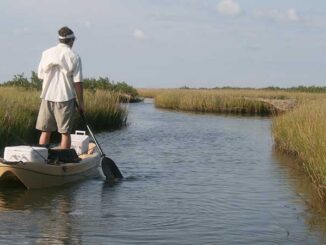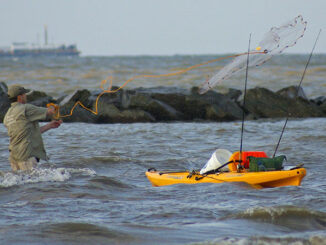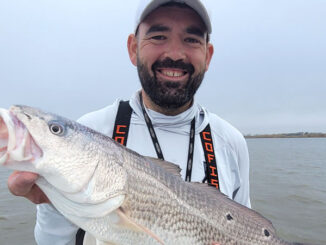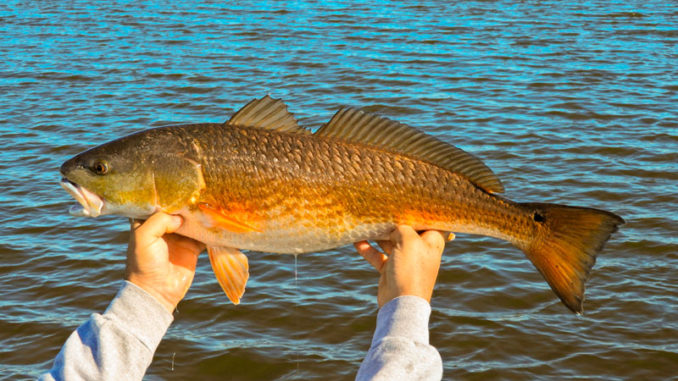
Slashing north winds pushed water toward the Gulf of Mexico. Pummeling rain mixed with sleet as a January front roared through the previous evening left icy puddles glistening like diamonds in the mudflats. Droopy marsh grass sparkled with frozen jewelry.
With the wind-driven low tide, little water remained in the marsh except in the deeper bayous and canals. We pulled up to an old decaying concrete dam stretched across a canal. We tried to bounce our soft plastic offerings off the well-weathered concrete so the temptations would fall next to the structure. If we threw too far, the lure snagged or topped the dam and we lost it. If we threw too short nothing would bite.
However, if the lure hit or dropped next to the structure, redfish struck the sinking bait immediately. Sometimes, we needed to drag the bait across the bottom. Without moving the boat, four of us caught more than 50 redfish by noon, most too big to keep. We returned to port with an ice chest brimming with limits of slot reds.
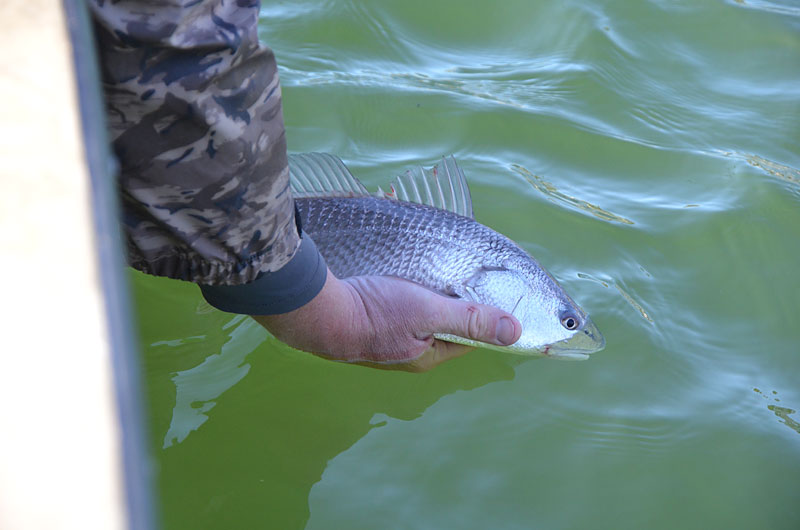
Few people enjoy heading into a winter storm to fish, but severe weather affects fishermen more than fish. Redfish can tolerate cold water much better than speckled trout and many other species. In bad conditions, anglers just need to find the fish.
“We had a tournament in Jefferson Parish in early 2022 and the weather was horrible,” recalled Mike Frenette, a professional redfish angler and guide with Redfish Lodge of Louisiana (504-782-0924, Laredfish.com) at Venice Marina. “The wind was blowing close to 30 miles per hour and the temperature was in the 30s. The wind sucked the water out of the marshes. In those conditions, redfish seek deeper holes and channels, but close to their ponds.”
Concentrated redfish
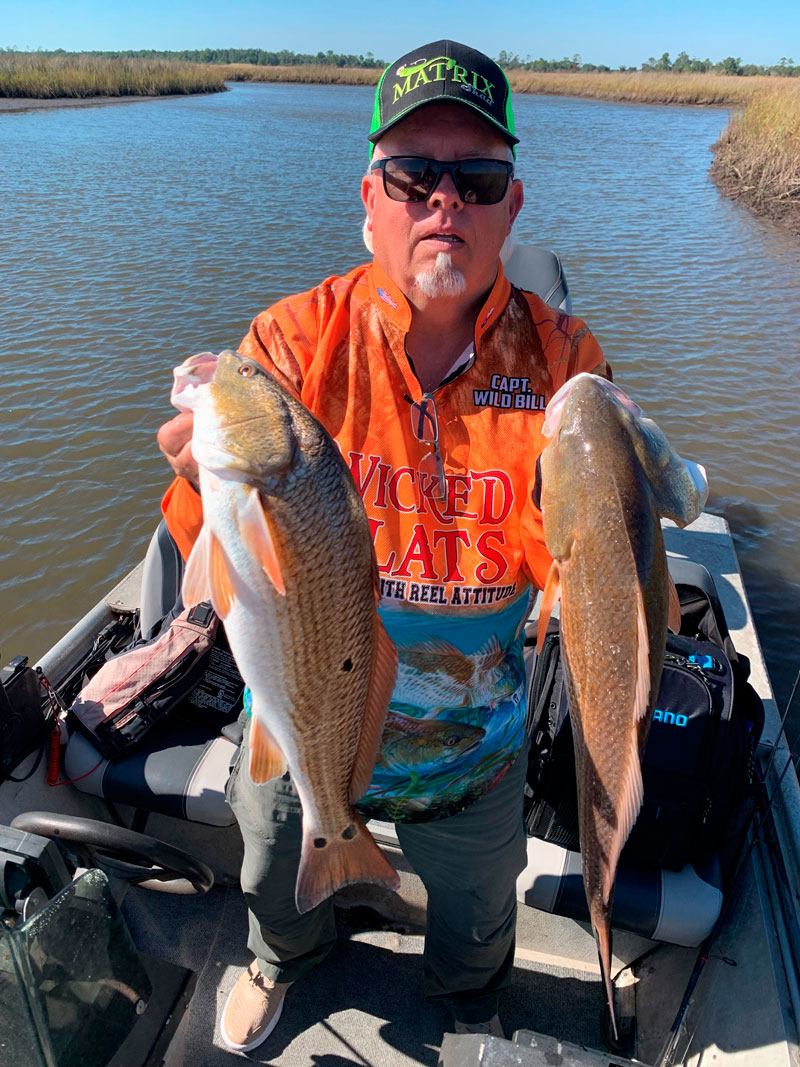
Strong, stinging winds can make any day in the marsh miserable, but winds can concentrate fish. When brutal north winds bring biting cold and create extremely low tides, prey species must leave their cover for deeper water. Large redfish and other predators commonly gather at the mouths of drains waiting for the tide to bring them breakfast.
“When it gets really cold, I’ll look for redfish around any drains, points or pockets, especially ones with current,” advised Bill “Wild Bill” Hancock with Reel Outlaw Charters (601-807-5811, Facebook, reeloutlawcharters.com) of Gulfport, Miss. “Most bayous hold water in the winter even during extreme low tides. I like to fish during a falling tide because it draws water out of the grass. When water comes out, it also pulls out the shrimp, crabs and little minnows into deeper water. Redfish will be right along the edge of the grass waiting for bait to come out.”
East Pearl River on the Louisiana-Mississippi line feeds a lush delta marsh bordering Lake Borgne. In the winter, Hancock regularly fishes the deep bayous, such as Bayou Caddy or Bayou La France, and other channels between Pearl River and Waveland, Miss.
“When the weather turns cold, redfish stay in the bayous,” Hancock said. “All of those bayous can provide good fishing for redfish in the winter. The marshes around Bay St. Louis also hold good fish. Even when the weather turns nasty, fishermen can always find a place to get out of the wind because the bayous twist and turn so much.”
Current flows farther and faster rounding the outside of bends. In doing so, tides scour deeper holes. During frigid temperatures, redfish drop into those holes where water stays relatively stable throughout the year.
“Some holes in those bayous drop to 20 feet deep,” Hancock said. “The reds are not necessarily in the deep holes, but they like to be near deep water in the winter. Reds might go into deep holes at night when the temperature drops, but when the sun comes up, they’ll move onto the flats. In clear water with a dark muddy bottom, sunlight will heat the mud.”
Seek the structure
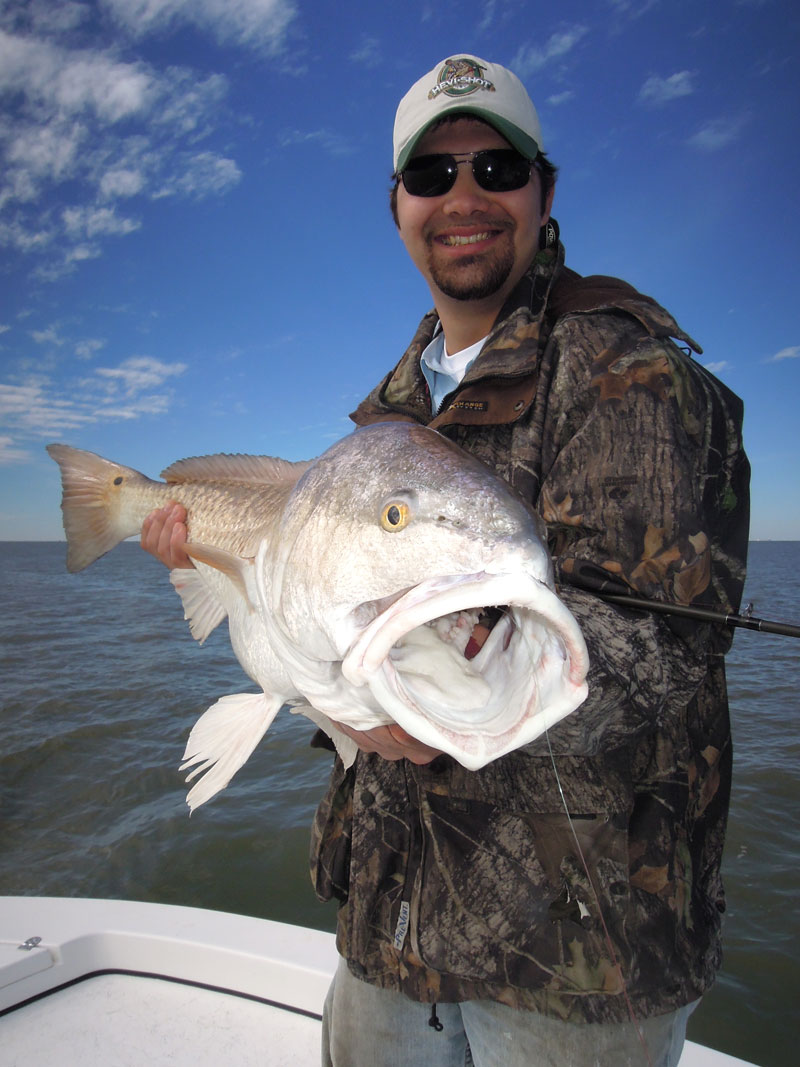
In Louisiana marshes, deep water typically means larger natural bayous and manmade canals. Dams or weirs cap many canals. These wood, shell, rock or concrete structures frequently attract redfish on bitter cold days. Hard concrete in the sun absorbs solar energy and radiates that slight warmth into the water. On a frosty day, a 1- or 2- degree temperature difference could mean everything to a cold-blooded fish. Rock holds more heat than concrete. Concrete holds more heat than wood. In the winter, redfish gather in huge numbers next to structures and might even rub against them and each other to keep warm.
“Redfish definitely relate to structure,” Frenette said. “Those structures are usually in a little deeper water and that’s where the fish want to go. In the winter, I like to find water about four to 10 feet deep. The redfish hug the bottom. When the water gets really cold, fish hold tight against the structures.”
Jetties, oyster reefs, bridge pilings, bulkheads and other hard structures also attract redfish in the winter. Petroleum wells and various other oil field structures dot many bays along the Louisiana coastline. Steel absorbs and radiates solar heat as well.
“Rocks, pilings and especially jetties attract a lot of bait,” Frenette said. “Even deep-water oyster reefs, rock piles and other hard structures make great places where fish can ambush bait. When I’m fishing structures like that, I throw a Strike King Red Eye Shad lipless crankbait parallel to the structure. I’ll tick it off the rocks and let it fall. It’s amazing how many hits we get as the lure hits the rock and starts to sink. I might also use a lipped crankbait that runs as deep as the structures.”
Powerful winds and tides can also muddy the water. However, mud doesn’t bother redfish. Spot-tails can tolerate a wide range of water clarities and salinities. Dark muddy water might hold a bit more heat on a cold day.
“Often, we find dirty conditions in the winter,” Frenette said. “When we get harsh winds howling out of the north, moving water turns things muddy, but water might only be muddy on the surface. It could be clean four or five feet down. Redfish can adapt to almost anything including cold and muddy conditions that might affect speckled trout much more. In cold, dirty water, we need to work baits extremely slowly.”
Fish slow
Locating prey primarily by smell and sound vibrations in the water, redfish can find food during the murkiest conditions. Lures that give off vibrations make it easier for them to find. Good baits for dirty water include rattling lipless and conventional crankbaits, Chatterbaits and spinnerbaits. Dragging jigheads over the bottom as slowly as possible also work. Along marshy shorelines, redfish hunker down in the mud to stay warm. They won’t move very far or fast, but might slurp something they can easily grab without expending too much energy.
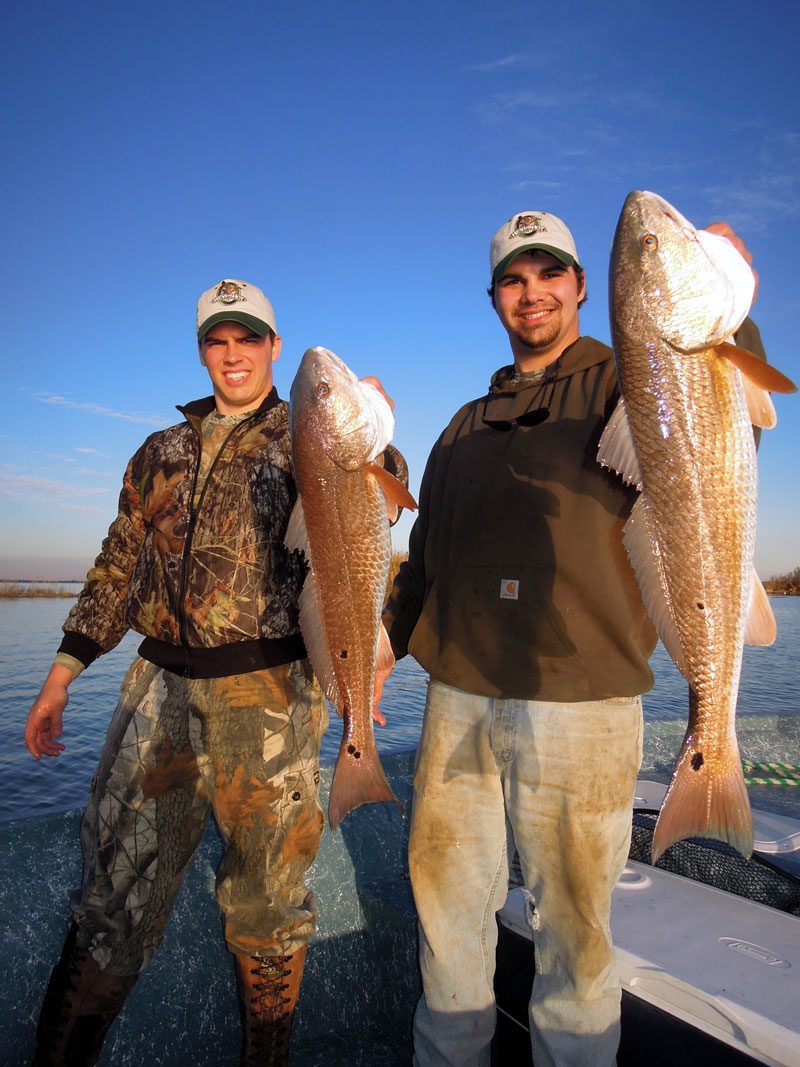
“We absolutely fish really slow right on the bottom in the winter,” Frenette said. “Instead of bouncing a bait, slide it along the bottom so it kicks up a little dirt. That simulates baitfish or crabs moving. In the winter, we need to bring the bait right past a redfish’s mouth. We almost need to hit redfish on the nose to make them bite.”
In frigid conditions, color and bait type rarely matters as much as placement. With bait scarce, redfish might gulp anything. Hit shoreline pockets or structure edges and pull baits over the drop-off into deep water. Don’t hesitate to fish the middle of the canal or bayou. Adding a small piece of shrimp to a jighead tipped with soft plastic helps reds smell a lure.
“When water turns really cold, I fish the same way I always do, but much slower,” Hancock said. “I’ll drag soft plastics on the bottom around points and drains. Hungry redfish in the winter won’t refuse many bait offerings.”
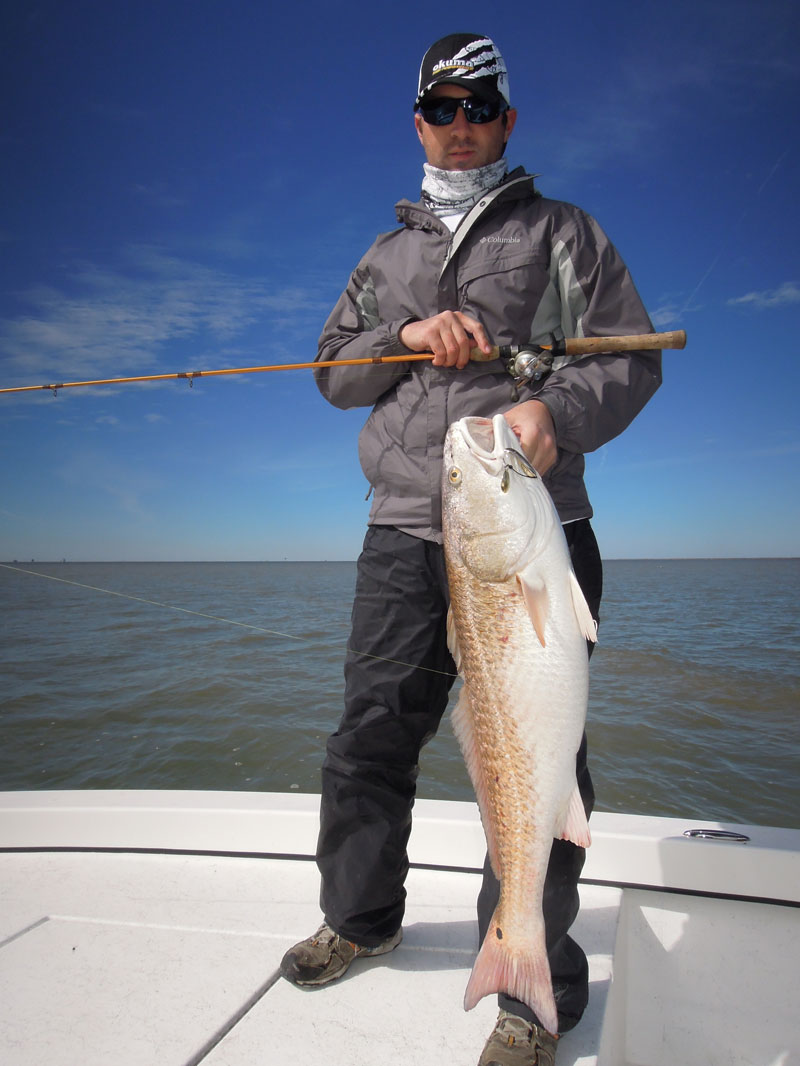
When redfish simply won’t hit lures, hook a live cocahoe to a jighead. Run the hook through its eyes or up through its bottom lip and out its nostril. Drag it slowly along the bottom, pausing periodically. The jighead creates a mud trail while the frantically struggling minnow provokes strikes.
Also try a fresh shrimp on a jighead. Remove its head and thread the shrimp body over the hook like rigging a plastic trailer. Let the bait sink to the bottom and remain in place a few seconds. Then, slowly drag it over the bottom, pausing occasionally. A popping cork tipped with live or dead bait or even a soft-plastic enticement can also prove deadly in the winter. Use a longer leader, about four to five feet, to get the bait deeper.
Nobody enjoys shivering and dripping with icy water, but manufacturers in recent years greatly improved foul weather gear. Now, sportsmen can buy reasonably priced weather suits that keep them warm and dry, allowing anglers to fish all day in comfort regardless of the conditions.
Remember the old saying, “A bad day fishing still beats a good day working.”
Sometimes, the best fishing can come on the worst days.
Worse than the cold: Don’t let your trip end in a “flash”
Anglers can overcome cold, rain, mud and other conditions by using the proper equipment, but nothing stops lightning. Lightning can strike anyone anywhere at any time without warning and usually kills what it hits.
Lightning frequently hits the highest object in its strike zone. That could mean anglers standing in a boat raising rods over their heads. When the possibility of lightning arises, run for shelter and sit it out.
“On one of the scariest days I’ve ever fished, an electrical storm was so bad that I thought we were in the middle of a war with so much thunder cracking around us,” remembered Shaw Grigsby, a professional angler and longtime host of a nationally syndicated television show. “I could just barely see another competitor standing up in his boat across the bay. I didn’t want to feel like a wimp if he was standing up. Then, I looked over again and he was not standing up any more so I sat down. I tucked my back to the wind and just sat there. Later, I found out that he went down because lightning struck his rod and folded him up. I just got lucky that day.”
When dangerous situations occur, don’t take chances. Keep safe on the water and don’t do anything stupid. No fish is worth a human life — particularly your own!
— John N. Felsher
